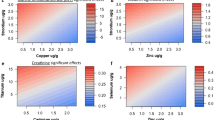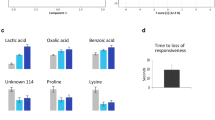Abstract
Wild-trapped starlings (Sturnus vulgaris) were fed concentrations of Morsodren (2, 4, and 8 ppm), DDE or Aroclor 1254 (5, 25, and 100 ppm), or malathion (8, 35, and 160 ppm) that were found to be sublethal in pen-reared Coturnix quail fed these amounts for 12 weeks. Plasma enzymes had to be measured earlier than planned in starlings fed Morsodren (at three weeks) or the organochlorine compounds (at seven weeks) because of unexpected, subsequent mortality. Variations in enzyme response were greater in wild than in pen-reared birds, but not enough to mask the toxicant-induced changes in enzyme activity. Cholinesterase activities decreased in birds fed Morsodren or malathion, and increased in those fed the organochlorine compounds. Lactate dehydrogenase activities increased two-fold in starlings fed Morsodren and two- to four-fold in those fed the organochlorine compounds, but only 50% in those fed malathion. Further examination of enzyme profiles showed that creatine kinase and aspartate aminotransferase activities increased two-to four-fold in birds fed Morsodren or the organochlorine compounds but not at all in those fed malathion. Thus the classes of environmental contaminants fed to starlings could be easily distinguished by these enzymatic parameters. Evaluation of enzymatic profiles appears to be a potentially valuable technique to monitor the presence of toxicants in wild populations, especially if used to complement standard chemical residue analyses. Here the residue analyses showed, after three weeks feeding, that mercury in the carcasses reflected the concentrations fed daily, whereas accumulation in the livers was two- to four-fold greater. After seven weeks feeding, liver residues of either organochlorine compound were about three-fold higher than the concentrations fed daily. However, four times as much DDE as Aroclor 1254 had accumulated in the carcasses.
Similar content being viewed by others
References
Casterline, J. L., Jr., and C. H. Williams: The effect of 28-day pesticide feeding on serum and tissue enzyme activities of rats fed diets of varying casein content. Toxicol. Appl. Pharmacol.18, 607 (1971).
Chen, T. S., F. K. Kinoshita, and K. P. Dubois: Acute toxicity and antiesterase action ofO-ethyl-S,S-diphenyl phophorodithioate (Hinosan). Toxicol. Appl. Pharmacol.23, 519 (1972).
Dieter, M. P.: Plasma enzyme activities in Coturnix quail fed graded doses of DDE, polychlorinated biphenyl, malathion and mercuric chloride. Toxicol. Appl. Pharmacol.27, 86 (1974).
Dubois, K. P.: Potentiation of the toxicity of organophosphorus compounds. Adv. Pest. Control Res.4, 117 (1961).
El-Aaser, A. A., E. Reid, and D. E. Stevenson: Alkaline phosphatase patterns in dieldrintreated dogs. Hoppe-Seyler's Z. Physiol. Chem.353, 667 (1972).
Frawley, J. P., E. C. Hagan, and O. G. Fitzhugh: Marked potentiation of mammalian toxicity from simultaneous administration of anticholinesterase compounds. J. Pharmacol. Exptl. Ther.121, 96 (1957).
Grice, H. C., M. L. Barth, H. H. Cornish, G. V. Foster, and R. H. Gray: Correlation between serum enzymes, isozyme patterns and histologically detectable organ damage. Fd. Cosmet. Toxicol.9, 847 (1971).
Gupta, P. K., and B. S. Paul: Effect of malathion on blood cholinesterase and its toxicity inGallus domesticus. Indian J. Exptl. Biol.9, 455 (1971).
Khaikina, B. I., U. A. Kuzminskaia, and S. M. Alekhina: The effect of some pesticides on the isoenzymatic activity of serum lactic dehydrogenase. Byul. Eksperim. Biol. i Med.70, 39 (1970).
Krampl, V.: Relationship between serum enzymes and histological changes in liver after administration of heptachlor in the rat. Bull. Environ. Contain. Toxicol.5, 529 (1971).
Kreitzer, J. F., and J. W. Spann: Tests of pesticidal synergism with young pheasants and Japanese quail. Bull. Environ. Contam. Toxicol.4, 250 (1973).
Lehotzky, K., and S. Bordas: Urinary and serum transaminase levels in rats with organic mercury poisoning. Acta Med. Acad. Sci. Hung.28, 139 (1971).
Luckens, M. M., and K. I. Phelps: Serum enzyme patterns in acute poisoning with organochlorine insecticides. J. Pharmaceut. Sci.58, 569 (1969).
Ludke, J. L.: Personal communication (1974).
Ludke, J. L., E. F. Hill, and M. P. Dieter: Cholinesterase (ChE) response and related mortality among birds fed ChE inhibitors. Arch. Environ. Contam. Toxicol. in press (1975).
Sasinovich, L. M., and L. Va. Voronina: Enzyme activity as a diagnostic test in liver injuries from some pesticides. Fermenty Nar. Khoz. Med. 1971, 213 (1971).
Schwetz, B. A., and G. L. Plaa: Catecholamine potentiation of carbon tetrachlorideinduced hepatotoxicity in mice. Toxicol. Appl. Pharmacol.14, 495 (1969).
Stickel, L. F., W. H. Stickel, and R. Christensen: Residues of DDT in brains and bodies of birds that died on dosage and in survivors. Science151, 1549 (1966).
Vallee, B. L., and D. D. Ulmer: Biochemical effects of mercury, cadmium, and lead. Ann. Rev. Biochem.41, 91 (1972).
Van Velzen, A. C., W. B. Stiles, and L. F. Stickel: Lethal mobilization of DDT by cowbirds. J. Wildl. Manage.36, 733 (1972).
Vos, G. H., H. L. Van Der Mass, and E. Ram: Toxicity of hexachlorobenzene in Japanese quail with special reference to porphyria, liver damage, reproduction, and tissue residues. Toxicol. Appl. Pharmacol.18, 944 (1971).
Walker, N. E.: The effect of malathion and malaoxon on esterases and gross development of the chick embryo. Toxicol. Appl. Pharmacol.19, 590 (1971).
Author information
Authors and Affiliations
Rights and permissions
About this article
Cite this article
Dieter, M.P. Further studies on the use of enzyme profiles to monitor residue accumulation in wildlife: Plasma enzymes in starlings fed graded concentrations of Morsodren, DDE, Aroclor 1254, and malathion. Arch. Environ. Contam. Toxicol. 3, 142–150 (1975). https://doi.org/10.1007/BF02220784
Received:
Accepted:
Issue Date:
DOI: https://doi.org/10.1007/BF02220784




